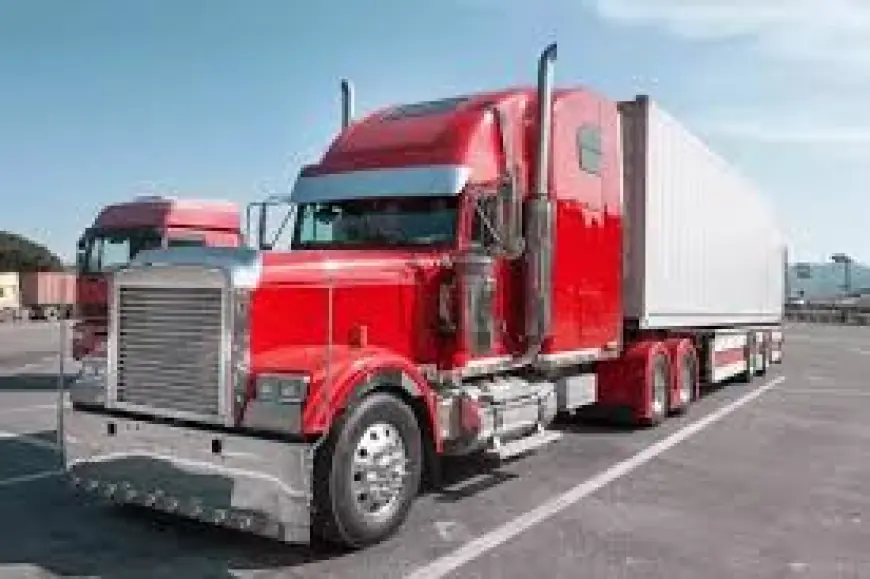Global Truck Market 2030 Set for Major Transformation
Several trends are shaping the global truck market, notably the increasing focus on sustainability and environmental responsibility.

The global truck market is undergoing a dynamic transformation, spurred by accelerating industrial activity, rising demand for efficient logistics, and the sweeping influence of technological innovations. As of 2024, the global truck market reached a valuation of USD 853.01 billion, and is projected to soar to USD 1159.54 billion by 2030, growing at a CAGR of 5.25%. Trucks remain indispensable to modern logistics, playing a pivotal role in the movement of goods, raw materials, and finished products across vast distances—both domestically and internationally.
With the emergence of e-commerce, the evolution of cross-border trade, infrastructure expansion, and growing emphasis on sustainability, the truck market is undergoing a significant overhaul. This article explores the multiple facets of this rapidly growing industry, its driving forces, regional dynamics, technological evolution, and the competitive landscape.
Industry Key Highlights
- Market Value (2024): USD 853.01 billion
- Market Value Forecast (2030): USD 1159.54 billion
- CAGR (2024-2030): 5.25%
- Fastest Growing Segment: Class 8 trucks (Heavy-duty)
- Fastest Growing Region: Asia-Pacific
- Key Technologies: Electric powertrains, autonomous systems, telematics
Download Free Sample Report: https://www.techsciresearch.com/sample-report.aspx?cid=1790
Emerging Trends Reshaping the Global Truck Market
1. E-Commerce and the Last-Mile Revolution
The explosion of e-commerce has significantly disrupted traditional supply chains. Consumer expectations for same-day or next-day delivery are now standard, which has driven demand for agile, efficient, and high-capacity delivery fleets. This phenomenon is encouraging the deployment of both light and medium-duty trucks in urban environments, where maneuverability and speed are critical.
Moreover, fleet owners are investing in smart logistics platforms and fleet management solutions to streamline operations, reduce delivery times, and improve route planning. Last-mile delivery solutions are also driving the adoption of electric trucks, particularly in densely populated cities with strict emissions regulations.
2. Technological Integration: From Telematics to AI
The incorporation of advanced telematics, autonomous driving systems, and artificial intelligence is revolutionizing truck manufacturing and operation. Vehicles now feature real-time GPS tracking, predictive maintenance systems, and driver monitoring technologies, all aimed at improving safety and efficiency.
Autonomous and semi-autonomous trucks are making headway, particularly for long-haul operations. Companies are experimenting with platooning technologies, where a convoy of trucks travels in close formation, reducing fuel consumption and human error.
3. Electrification and Green Trucking
Environmental sustainability is a major priority for governments and corporations alike. The development and deployment of electric trucks (e-trucks) and alternative fuel vehicles (like hydrogen fuel cell trucks) are gaining significant traction. Leading OEMs are investing heavily in electric powertrains, driven by the need to comply with strict emissions regulations and reduce operational costs.
In regions like Europe and North America, regulatory mandates around emissions are pushing logistics companies to transition to greener fleets. As battery technologies improve and charging infrastructure expands, electric trucks are expected to take up a significant market share by 2030.
4. Fleet Digitization and Predictive Maintenance
Fleet operators are rapidly digitizing their vehicles with integrated software that helps manage everything from cargo loads to driver behavior. One of the most transformative trends is predictive maintenance, where IoT sensors detect and report potential vehicle failures before they occur, preventing costly breakdowns and delays.
This data-centric approach to vehicle management is enhancing operational uptime, minimizing maintenance costs, and boosting the overall productivity of truck fleets.
Market Drivers Accelerating Growth
1. Surging Demand in Logistics and Freight Transport
Global trade volumes are increasing, creating heightened demand for robust logistics infrastructure. Trucks form the backbone of overland freight transportation, especially in the final stretch of the supply chain where rail and air transport are less effective. As industries expand and cross-border trade intensifies, so too does the need for efficient trucking solutions.
2. Rapid Infrastructure Development
Emerging economies are investing significantly in road, highway, and transportation infrastructure. Governments across Asia-Pacific, the Middle East, and Africa are actively upgrading transportation networks to support regional trade. This development directly correlates with higher demand for medium and heavy-duty trucks.
3. Rise in Industrialization and Urbanization
Urbanization is intensifying, especially in developing regions, leading to increased construction activity, rising industrial output, and the growth of retail networks. These sectors rely heavily on trucks for material movement, further boosting market demand.
4. Need for Time-Sensitive Delivery
From pharmaceutical logistics to fast fashion, several industries require precise, time-bound deliveries. Trucks offer unmatched flexibility and door-to-door service, making them indispensable for such applications.
Market Segmentation Insights
By Class
- Class 3-6 Trucks (Light to Medium Duty): Ideal for urban logistics, last-mile delivery, and shorter routes.
- Class 7-8 Trucks (Heavy Duty): Dominant in long-haul freight, industrial goods transportation, and construction.
Class 8 trucks have emerged as the fastest-growing segment. These vehicles, including semis and tractor-trailers, are vital for long-distance freight. Their large payload capacity, durability, and now increasingly advanced features (like ADAS, telematics, and alternative fuel capabilities) are driving their growth.
By Fuel Type
- Diesel: Still dominant, especially in heavy-duty applications, but facing regulatory pressure.
- Electric: Fastest-growing due to zero-emission benefits and increasing government incentives.
- Natural Gas & Alternative Fuels: Gaining ground as transitional solutions before full electrification.
By End-User Industry
- Logistics & Transportation
- Construction & Mining
- Agriculture
- Retail & E-commerce
- Waste Management and Municipal Services
Regional Outlook
Asia-Pacific: Leading the Global Growth
The Asia-Pacific region, particularly China, India, and Southeast Asia, is experiencing unprecedented growth. Factors such as rapid urbanization, government infrastructure projects, rising e-commerce, and manufacturing activity contribute to the demand for trucks. China leads in both production and consumption, while India is seeing fast growth in medium and heavy-duty trucks.
North America
The U.S. is at the forefront of autonomous and electric truck innovations. Strong logistics infrastructure, high freight movement, and substantial investment in clean technologies support market expansion.
Europe
Europe is focused on reducing emissions. Countries like Germany, France, and the Netherlands are investing in EV charging stations, zero-emission zones, and subsidies for electric commercial vehicles.
Middle East & Africa
Infrastructure boom, particularly in the Gulf Cooperation Council (GCC) countries, is stimulating demand for heavy-duty trucks. Africa is gradually emerging, supported by mining and agriculture sectors.
Future Outlook: Driving Towards Digital and Green Logistics
The global truck market is on a path of evolution and innovation. Between now and 2030, the focus will shift from traditional diesel-powered trucks to smart, connected, and cleaner vehicles. Governments and corporations will drive sustainability through regulations and investments, while OEMs will respond with advanced offerings.
- Electrification will continue to surge with improvements in battery efficiency and cost reductions.
- Autonomous trucking will see greater experimentation in long-haul routes.
- Connected fleets will become the norm, leveraging cloud-based platforms for fleet health, safety, and optimization.
- Fleet leasing and subscription models are expected to rise, particularly in urban settings.
Competitive Analysis
The global truck market is highly competitive and fragmented, with both global giants and regional players contributing to growth. Leading companies are aggressively investing in R&D, new product development, strategic alliances, and digital transformation.
Major Players:
- Daimler Truck AG – Pioneer in electric trucks and autonomous freight solutions.
- Volvo Group – Focused on sustainability, electric trucks, and smart transport systems.
- PACCAR Inc – Known for robust fleet management technologies.
- MAN Truck & Bus SE – Innovating with alternative drivetrains and digital cockpit interfaces.
- Scania CV AB – Investing in electrification and fuel efficiency.
- International Motors, LLC – Strong presence in North America.
- Isuzu Motors Limited – Leading in light-duty and medium-duty segments.
- Hino Motors, Ltd – Emphasizing hybrid powertrains and urban delivery models.
- Ford Motor Company – Scaling up electrified commercial vehicles.
- Tata Motors Ltd – A dominant force in India with a broad product range across classes.
10 Key Benefits of the Research Report
- Accurate Market Forecasts: Provides precise data-driven projections till 2030.
- In-Depth Segmentation: Detailed analysis by truck class, fuel type, end user, and region.
- Competitive Benchmarking: Insights into major players and their strategic priorities.
- Technological Trends: Covers emerging innovations such as electric trucks and AI.
- Regulatory Impact: Assesses how global and regional policies influence growth.
- Growth Drivers: Comprehensive analysis of what is propelling the market forward.
- Challenges and Risks: Understand potential obstacles and how to mitigate them.
- Opportunities Analysis: Identifies untapped markets and emerging use cases.
- Regional Insights: Detailed coverage of regional trends and dynamics.
- Investment Guide: A reliable tool for investors, strategists, and policymakers.
Conclusion
The global truck market is shifting gears toward a smarter, more sustainable, and more connected future. With demand surging across both developed and developing economies, the industry is on a transformative path. From heavy-duty trucks enabling international trade to electric trucks redefining urban logistics, the sector is ripe with opportunity.
As competition intensifies, innovation will become the key differentiator. Stakeholders—from manufacturers and logistics companies to policymakers and investors—must stay agile and informed to capitalize on the market's potential. The next decade promises a powerful journey of growth, automation, and green transformation in the world of trucking.
Contact Us-
Mr. Ken Mathews
708 Third Avenue,
Manhattan, NY,
New York – 10017
Tel: +1-646-360-1656
Email: [email protected]
Website: www.techsciresearch.com
What's Your Reaction?
 Like
0
Like
0
 Dislike
0
Dislike
0
 Love
0
Love
0
 Funny
0
Funny
0
 Angry
0
Angry
0
 Sad
0
Sad
0
 Wow
0
Wow
0



















































